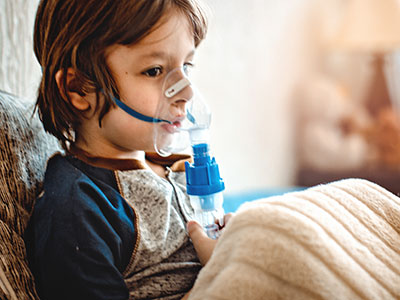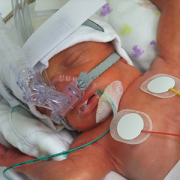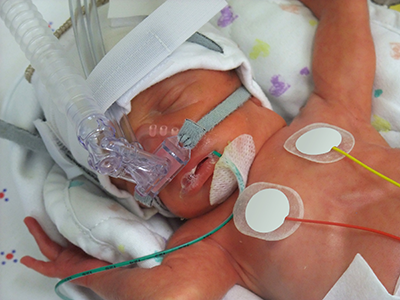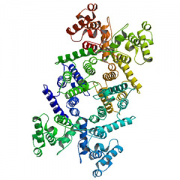
It’s long been known that colds, flu and other respiratory illnesses are major triggers for asthma exacerbations, says asthma expert Stephen J. Teach, M.D., MPH. Consequently, a significant body of research has focused on trying to figure out what’s happening on the cellular or molecular level as these illnesses progress to exacerbations.
People with asthma can be indistinguishable from people who don’t have this chronic airway disease – until they have an asthma attack, also known as an exacerbation. During these events, their airways become inflamed and swollen and produce an abundance of mucus, causing dangerous narrowing of the bronchial tubes that leads to coughing, wheezing and trouble breathing. These events are a major cause of morbidity and mortality, leading to the deaths of 10 U.S. residents every day, according to the Centers for Disease Control and Prevention.
It’s long been known that colds, flu and other respiratory illnesses are major triggers for asthma exacerbations, says Children’s National in Washington, D.C., asthma expert Stephen J. Teach, M.D., MPH. Consequently, a significant body of research has focused on trying to figure out what’s happening on the cellular or molecular level as these illnesses progress to exacerbations. Targeted searches have identified several different molecular pathways that appear to be key players in this phenomenon. However, Dr. Teach says researchers have been missing a complete and unbiased snapshot of all the important pathways in illness-triggered exacerbations and how they interrelate.
To develop this big picture view, Dr. Teach and Inner-City Asthma Consortium colleagues recruited 208 children ages 6-17 years old with severe asthma – marked by the need for daily doses of inhaled corticosteroids, two hospitalizations or systemic corticosteroid treatments over the past year, and a high concentration of asthma-associated immune cells – from nine pediatric medical centers across the country, including Children’s National. (Inhaled corticosteroids are a class of medicine that calms inflamed airways.) The researchers collected samples of nasal secretions and blood from these patients at baseline, when all of them were healthy.
Then, they waited for these children to show symptoms of respiratory illnesses. Within six days of cold symptoms, the researchers took two more samples of nasal secretions and blood. They also administered breathing tests to determine whether these respiratory illnesses led to asthma exacerbations and recorded whether these patients were treated with systemic corticosteroids to stem the associated respiratory inflammation.
The researchers examined nasal fluid samples for evidence of viral infection during illness and used analytical methods to identify the causative virus. They analyzed all the samples they collected for changes in concentrations of various immune cells. They also looked globally in these samples for changes in gene expression compared with baseline and between the two collection periods during respiratory illness.
Together, this information told the molecular story about what took place after these children got sick and after some of them developed exacerbations. Of the 208 patients recruited, 106 got respiratory illnesses during the six-month study period, leading to a total of 154 illness events. Of those, 47 caused exacerbations, and 107 didn’t.
About half the exacerbations appeared to have been triggered by a rhinovirus, a cause of common colds, the research team reports in a study published online April 8, 2019, in Nature Immunology. The other children’s cold-like symptoms could have been triggered by pollution, allergens or other irritants.
In most exacerbations, virally triggered or not, the researchers saw early activation of a network of genes that appeared to be associated with SMAD3, a signaling molecule already known to be involved in airway inflammation. At the same time, genes that control a set of immune cells known as lymphocytes were turned down. However, as the exacerbation progressed and worsened, the researchers saw gene networks turned on that related to airway narrowing, mucus hypersecretion and activation of other immune cells.
Exacerbations triggered by viruses were associated with multiple inflammatory pathways, in contrast to those in which viruses weren’t found, which were associated with molecular pathways that affected cells in the airway lining.
The researchers validated these findings in 19 patients who each got respiratory illnesses at least twice during the study period but only developed an exacerbation during one of these episodes, finding the same upregulated and downregulated molecular pathways in these patients as in the study population as a whole. They also identified a set of molecular risk factors in patients at baseline – signatures of gene activation that appeared to put patients at risk for exacerbations when they got sick. When patients were treated with systemic corticosteroids during exacerbations, these medicines appeared to restore only some of the affected molecular pathways to normal, healthy levels. Other molecular pathways remained markedly changed.
Each finding could represent a new target for drugs that could prevent or more effectively treat exacerbations, keeping more patients with asthma healthy and out of the hospital.
“Our consortium study found increased gene expression of enzymes that produce molecules that contribute to narrowed airways and dilated blood vessels,” Dr. Teach adds. “This is especially intriguing because drugs that target kallikreins or bradykinin may help treat asthma attacks that aren’t caused by viruses.”
In addition to Dr. Teach, study co-authors include Lead Author Matthew C. Altman, University of Washington; Michelle A. Gill, Baomei Shao and Rebecca S. Gruchalla, all of University of Texas Southwestern Medical Center; Elizabeth Whalen and Scott Presnell of Benaroya Research Institute; Denise C. Babineau and Brett Jepson of Rho, Inc.; Andrew H. Liu, Children’s Hospital Colorado; George T. O’Connor, Boston University School of Medicine; Jacqueline A. Pongracic, Ann Robert H. Lurie Children’s Hospital of Chicago; Carolyn M. Kercsmar and Gurjit K. Khurana Hershey, , Cincinnati Children’s Hospital; Edward M. Zoratti and Christine C. Johnson, Henry Ford Health System; Meyer Kattan, Columbia University College of Physicians and Surgeons; Leonard B. Bacharier and Avraham Beigelman, Washington University, St. Louis; Steve M. Sigelman, Peter J. Gergen, Lisa M. Wheatley and Alkis Togias, National Institute of Allergy and Infectious Diseases; and James E. Gern, William W. Busse and Senior author Daniel J. Jackson, University of Wisconsin School of Medicine and Public Health.
Funding for research described in this post was provided by the National Institute of Allergy and Infectious Diseases under award numbers 1UM1AI114271 and UM2AI117870; CTSA under award numbers UL1TR000150, UL1TR001422 and 5UL1TR001425; the National Institutes of Health under award number UL1TR000451; CTSI under award number 1UL1TR001430; CCTSI under award numbers UL1TR001082 and 5UM1AI114271; and NCATS under award numbers UL1 TR001876 and UL1TR002345.














